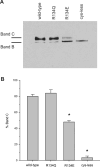Two positively charged amino acid side-chains in the inner vestibule of the CFTR channel pore play analogous roles in controlling anion binding and anion conductance
- PMID: 34023918
- PMCID: PMC11073087
- DOI: 10.1007/s00018-021-03859-x
Two positively charged amino acid side-chains in the inner vestibule of the CFTR channel pore play analogous roles in controlling anion binding and anion conductance
Abstract
Positively charged amino acid side-chains play important roles in anion binding and permeation through the CFTR chloride channel. One pore-lining lysine residue in particular (K95) has been shown to be indispensable for anion binding, conductance, and selectivity. Here, we use functional investigation of CFTR to show that a nearby arginine (R134) plays a functionally analogous role. Removal of this positive charge (in the R134Q mutant) drastically reduces single-channel conductance, weakens binding of both permeant and blocking anions, and abolishes the normal anion conductance selectivity pattern. Each of these functional effects was reversed by a second-site mutation (S1141K) that introduces an ectopic positive charge to a nearby pore-lining residue. Substituted cysteine accessibility experiments confirm that R134-but not nearby residues in the same transmembrane helix-is accessible within the pore lumen. These results suggest that K95 and R134, which are very close together within the inner vestibule of the pore, play analogous, important roles, and that both are required for the normal anion binding and anion conductance properties of the pore. Nevertheless, that fact that both positive charges can be "transplanted" to other sites in the inner vestibule with little effect on channel permeation properties indicates that it is the overall number of charges-rather than their exact locations-that controls pore function.
Keywords: Anion permeation; Channel pore; Channel structure; Chloride channel; Cystic fibrosis transmembrane conductance regulator.
Conflict of interest statement
The authors declare that they have no competing interest.
Figures







Similar articles
-
Functionally additive fixed positive and negative charges in the CFTR channel pore control anion binding and conductance.J Biol Chem. 2022 Mar;298(3):101659. doi: 10.1016/j.jbc.2022.101659. Epub 2022 Jan 29. J Biol Chem. 2022. PMID: 35101441 Free PMC article.
-
Location of a permeant anion binding site in the cystic fibrosis transmembrane conductance regulator chloride channel pore.J Physiol Sci. 2015 May;65(3):233-41. doi: 10.1007/s12576-015-0359-6. Epub 2015 Feb 12. J Physiol Sci. 2015. PMID: 25673337 Free PMC article.
-
Regulation of conductance by the number of fixed positive charges in the intracellular vestibule of the CFTR chloride channel pore.J Gen Physiol. 2010 Mar;135(3):229-45. doi: 10.1085/jgp.200910327. Epub 2010 Feb 8. J Gen Physiol. 2010. PMID: 20142516 Free PMC article.
-
Mechanism of chloride permeation in the cystic fibrosis transmembrane conductance regulator chloride channel.Exp Physiol. 2006 Jan;91(1):123-9. doi: 10.1113/expphysiol.2005.031757. Epub 2005 Sep 12. Exp Physiol. 2006. PMID: 16157656 Review.
-
CFTR: what's it like inside the pore?J Exp Zool A Comp Exp Biol. 2003 Nov 1;300(1):69-75. doi: 10.1002/jez.a.10311. J Exp Zool A Comp Exp Biol. 2003. PMID: 14598388 Review.
Cited by
-
Role of Hydrophobic Amino-Acid Side-Chains in the Narrow Selectivity Filter of the CFTR Chloride Channel Pore in Conductance and Selectivity.J Membr Biol. 2023 Dec;256(4-6):433-442. doi: 10.1007/s00232-023-00294-w. Epub 2023 Oct 12. J Membr Biol. 2023. PMID: 37823914
References
MeSH terms
Substances
Grants and funding
LinkOut - more resources
Full Text Sources
Other Literature Sources

